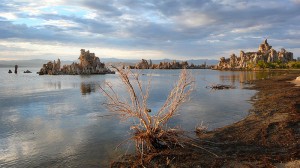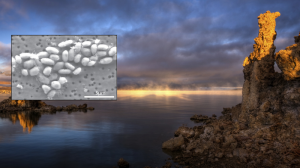TUESDAY, 28 DECEMBER 2010
In a recent press release from NASA (which can be found here), a team of researchers from the University of Arizona announced that they have “changed the fundamental knowledge about what comprises all known life on Earth.” The team has found a strain of bacteria in Mono Lake in California that can incorporate arsenic into its DNA. Their findings have been published in the journal Science Express (abstract available here).This research has generated much interest because up till now no life form has been found that can substitute one of the six crucial elements for life (carbon, phosphorus, nitrogen, sulphur, hydrogen and oxygen) for another. The press release from NASA gives the impression that this strain of bacteria uses arsenic in place of phosphorous. This would imply that the bacteria have a different biochemistry to the rest of life on Earth. If true, this finding could have huge implications in searching for extraterrestrial life. However, the study has also generated much controversy; many argue that the science was not robust.
The researchers collected sediment from the bottom of Mono Lake, which has a very high arsenic concentration. They then grew colonies of microorganisms found in the sediment in artificial growth mediums, supplemented either by phosphorous or an increasing concentration of arsenic. They found that a strain of bacteria from the genus Halomonas could survive and grow at arsenic concentrations about four times that of the lake. Whilst cells grew much faster if supplemented with phosphorous, they grew much slower if not supplemented with either phosphorous or arsenic. Further studies involving radioactive labeling seemed to indicate that the bacteria produced metabolites containing arsenic. Also, mass spectroscopy of DNA from the bacteria showed that those bacteria grown with arsenic contained a higher proportion of arsenic in their DNA than those grown with phosphorous. So where is the controversy?
Firstly, electron microscopy images show the cells grown in the arsenic medium displaying features that usually indicate that an essential growth substance is limited. Secondly, in the radioactive labeling study, issues with experimental techniques may mean that the arsenic found was not actually in the cell metabolites. Thirdly, in the mass spectroscopy study, whilst bacteria grown in arsenic had a higher proportion of arsenic in their DNA, the absolute amount of arsenic was still very low compared to phosphorus.
Therefore, other scientists have argued that the findings can be explained by saying that the bacteria are using methods to limit the damage caused by the arsenic and are not “thriving” at all. Despite all the media hype, it is very unlikely that the bacteria are a “second genesis” of life. Whilst it is true that the bacterial strain has adapted to living in arsenic concentrations that would kill most other organisms, they have nevertheless evolved from the same common ancestor. It appears the NASA-funded research has not changed our “fundamental knowledge” after all.
For those who are interested, the following blog article has some thought-provoking insights into this research as well as a more in depth analysis of the experimental methods and results.


